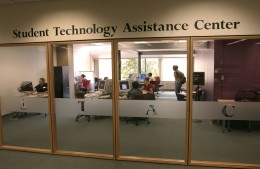
When the STAC started, building websites, scanning pictures, editing video and creating PowerPoint presentations—these assignments began to pop up on curricula campus-wide as faculty members got the ball rolling and appropriately handed off techno-inquiries to the STAC.
Ten years ago, four computers, a scanner and a video-capture station unceremoniously appeared together in Allyn Hall.
Staff was assigned to the location.
Students were advised to check out the latest campus resource.
And that was it.
“It was all very experimental. They didn’t know if it was going to be around in a year or two,” said Will Davis, coordinator for the Student Technology and Assistance Center (STAC). “We decided just to put it out there and see if anybody would come. And they did.”
A decade later and the STAC is still racking up awards for its service to students, both on and off campus.
This year, STAC staffer Beth Anderson received the President’s Award for Excellence (PAFE) Spirit of Innovation Award for her work with the Upward Bound Program, which seeks to get more students to graduate from both high school and college. Five years after it was created, the STAC got the PAFE Outstanding Unit Award.
Celebrate 10 years of student success at the STAC birthday party Thursday, Oct. 20, from 2‑3 p.m. on the second floor of the Dunbar Library. Cupcakes will be available and iTunes gift cards will be raffled to lucky winners.
The STAC started with a simple idea to fill a need.
A crescendo of interest had been growing among students to incorporate more technology into their learning experience. At the same time, the faculty needed a place to send them to get the hand-holding help they often could not offer.
Davis said administrators with the University Libraries and the College of Education and Human Services (CEHS) astutely recognized the need and pushed hard for the STAC’s creation, particularly Lake Campus Dean Bonnie Mathies.
“We found initial space in the ERC and cobbled together bits and pieces of equipment,” said Mathies, formerly with the CEHS. “But the best and most important part was finding the right person to lead the STAC who could translate our ideas into reality. Will Davis was that person.”
Davis said it was clear that students were no longer content to just write a paper. Students really began wanting to incorporate all the new multimedia into their presentations and coursework.
“But there wasn’t really a place where students could go on campus, not only to access the hardware and the software, but also to have assistance with it,” said Davis, “because many of these things were new ideas.”
Building websites, scanning pictures, editing video and creating PowerPoint presentations—these assignments began to pop up on curricula campus-wide as faculty members got the ball rolling and appropriately handed off techno-inquiries to the STAC.
“Faculty could assign a cutting-edge project and not have to worry about tech support,” said Davis. “They could send their students to us. And that was how we marketed ourselves.”
“I am sure that many times faculty weren’t sure just what they would get as a result. Once students had access to equipment and assistance, there was a synergy in STAC and everyone wanted more of everything,” said Mathies.
In a flurry, the STAC took flight. Peer institutions began to take note.
Universities across the country were reading and hearing about the STAC.
Davis said the river of inquiries ran fast and deep. People wanted learn how and why the unit was created. Unsolicited phone calls from other educators asking to stop by for a visit were common.
“It’s still a unique asset,” said Davis. “But now we see more STAC-like facilities at universities in our region and across the country.”
Its nimble nature was part of the reason. As technology and students have changed, so has the STAC.
For example, a couple of years ago the STAC opened a podcast studio called The Pod. Davis said it was the first higher education institution at the time to have a designated place for podcasting, and made national news.
The latest example might be the push toward mobile technology. Davis said a lot of faculty are looking for ways to incorporate mobility into the classroom.
“We’ve started thinking about how we could expand our services beyond our physical space. Technology has evolved in such a way that not all students need to come to us,” said Davis.
The future at the STAC might also include iPads and more tablet-based education. But there is one thing Davis hopes to always maintain.
“There’s just something about good customer service that just never goes out of fashion. I think our future, our next 10 years are about maintaining that standard of excellence and keeping an eye out for how technology continues to change our lives,” said Davis.
“We have to look at current technology and see how our students are using it and then take their lead. That will keep us busy for 10 more years.”

 From reluctant student to community leader
From reluctant student to community leader  Fall funhouse
Fall funhouse  WOW factor
WOW factor  Wright State and Sinclair College partner to launch engineering technology degree pathway
Wright State and Sinclair College partner to launch engineering technology degree pathway  From classroom to hall of fame
From classroom to hall of fame 